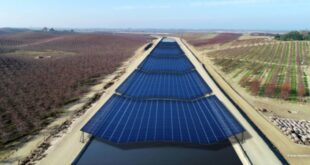Representatives of Cedars-Sinai Medical Center and its new Groundwater Re-use Project were lauded last Thursday during a celebration of the new water reuse system. The system is projected to save up to 29 million gallons of drinking water annually – the equivalent of supplying water for 267 homes.
On-hand for the festivities were representatives of the Metropolitan Water District (MWP) of Southern California, Los Angeles Department of Water and Power (LADWP) General Manager David H. Wright, Board of Water and Power Commissioner Christina Noonan and personnel from Cedars-Sinai. Also present was Los Angeles mayor Eric Garcetti.
“Los Angeles is changing how we think about water, by rewarding those who conserve,” said Mayor Garcetti. “At a moment when climate change and drought are becoming the new normal, the Cedars-Sinai treatment facility shows how property owners can help us better withstand the effects — through a strong commitment to conservation and sustainable design.”
The underground system, developed by Cedars-Sinai and external contractor, Rethink H2O of Chapel Hill, North Carolina, captures water flowing through an aquifer beneath the medical center. The system cleans the water and pumps it to help cool the hospital’s air conditioning. It is expected to also be used for irrigation in the near future.
Groundwater runs under portions of the city, including the area in West Los Angeles where the Cedars Sinai Medical Center campus is located. In areas where groundwater is present, it must be diverted in order to maintain the structural safety of the buildings above it. Cedars-Sinai installed a recycling system to reuse the groundwater instead of discharging it to the sewer.
The system which now provides 50-80 percent of the water used by Cedars-Sinai’s cooling towers, will offset the need for using drinking water for this function. However, the processed groundwater is not used for patient or staff purposes.
“Cedars-Sinai is proudly committed to water conservation, and our Ground Water Re-Use System has taken this to a new level,” said Richard B. Jacobs, executive vice president and chief strategy officer at Cedars-Sinai. “Large institutions and companies have a vital role to play in the environmental health of our city, and we are so pleased to do our part. We look forward to working with Mayor Garcetti and others here today to advance this important agenda in the years ahead.”
The project, which cost $1.2 million to design and build, has slashed Cedars-Sinai’s water bill by $365,000 a year. Financial assistance for the project came from LADWP who provided a $155,355 incentive through its Technical Assistance Program (TAP). TAP offers rebates for the installation of water-saving projects and equipment to commercial, industrial and institutional customers as well as multifamily residential customers in Los Angeles.
“Many customers don’t realize that making investments in efficiency can actually pay for the improvement in reduced energy or water costs in a few short years,” said David Wright, general manager of the DWP. “In this case, the rebate provided to Cedars-Sinai combined with water savings will pay for the total project cost in less than five years. We want to partner with more of our customers on projects like this, especially our commercial customers whose water use is about 20 percent of the total water we supply to the city annually. The more water we save, the less costly, imported water we have to supply our customers, which ensures a resilient water future for Los Angeles.”
The MWD also assisted in the project awarding Cedars-Sinai an additional $168,000 through its Water Savings Incentive Program. MWD encourages water savings at businesses and industrial facilities by providing cash incentives for the installation of water-saving technologies and devices, a part of a $43 million annual effort to help Southern California conserve water.
“Metropolitan is looking for opportunities to save water everywhere, in homes, businesses, factories and farms,” said Brad Coffey, manager of MWD’s Water Resource Management Group. “We have a host of incentives and rebates to help anyone who has an idea or project to use water more efficiently, from individuals who want to replace their grass with California native plants, to commercial facilities, like Cedars-Sinai, that want to install innovative technologies.”
 California Water News Daily Your Source For Water News in California
California Water News Daily Your Source For Water News in California


